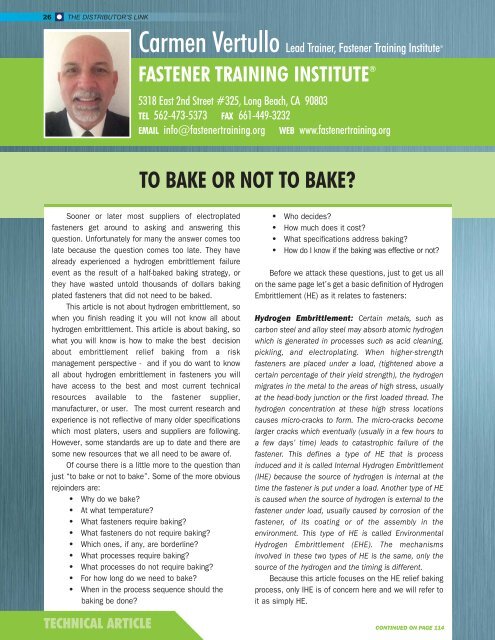WINTER 2016
Distributor's Link Magazine Winter Issue 2016 / Vol 39 No1
Distributor's Link Magazine Winter Issue 2016 / Vol 39 No1
Create successful ePaper yourself
Turn your PDF publications into a flip-book with our unique Google optimized e-Paper software.
26 THE DISTRIBUTOR’S LINK<br />
Carmen Vertullo Lead Trainer, Fastener Training Institute ®<br />
FASTENER TRAINING INSTITUTE ®<br />
5318 East 2nd Street #325, Long Beach, CA 90803<br />
TEL 562-473-5373 FAX 661-449-3232<br />
EMAIL info@fastenertraining.org WEB www.fastenertraining.org<br />
TO BAKE OR NOT TO BAKE?<br />
Sooner or later most suppliers of electroplated<br />
fasteners get around to asking and answering this<br />
question. Unfortunately for many the answer comes too<br />
late because the question comes too late. They have<br />
already experienced a hydrogen embrittlement failure<br />
event as the result of a half-baked baking strategy, or<br />
they have wasted untold thousands of dollars baking<br />
plated fasteners that did not need to be baked.<br />
This article is not about hydrogen embrittlement, so<br />
when you finish reading it you will not know all about<br />
hydrogen embrittlement. This article is about baking, so<br />
what you will know is how to make the best decision<br />
about embrittlement relief baking from a risk<br />
management perspective - and if you do want to know<br />
all about hydrogen embrittlement in fasteners you will<br />
have access to the best and most current technical<br />
resources available to the fastener supplier,<br />
manufacturer, or user. The most current research and<br />
experience is not reflective of many older specifications<br />
which most platers, users and suppliers are following.<br />
However, some standards are up to date and there are<br />
some new resources that we all need to be aware of.<br />
Of course there is a little more to the question than<br />
just “to bake or not to bake”. Some of the more obvious<br />
rejoinders are:<br />
Why do we bake?<br />
At what temperature?<br />
What fasteners require baking?<br />
What fasteners do not require baking?<br />
Which ones, if any, are borderline?<br />
What processes require baking?<br />
What processes do not require baking?<br />
For how long do we need to bake?<br />
• When in the process sequence should the<br />
baking be done?<br />
TECHNICAL ARTICLE<br />
Who decides?<br />
•<br />
How much does it cost?<br />
What specifications address baking?<br />
How do I know if the baking was effective or not?<br />
Before we attack these questions, just to get us all<br />
on the same page let’s get a basic definition of Hydrogen<br />
Embrittlement (HE) as it relates to fasteners:<br />
Hydrogen Embrittlement: Certain metals, such as<br />
carbon steel and alloy steel may absorb atomic hydrogen<br />
which is generated in processes such as acid cleaning,<br />
pickling, and electroplating. When higher-strength<br />
fasteners are placed under a load, (tightened above a<br />
certain percentage of their yield strength), the hydrogen<br />
migrates in the metal to the areas of high stress, usually<br />
at the head-body junction or the first loaded thread. The<br />
hydrogen concentration at these high stress locations<br />
causes micro-cracks to form. The micro-cracks become<br />
larger cracks which eventually (usually in a few hours to<br />
a few days’ time) leads to catastrophic failure of the<br />
fastener. This defines a type of HE that is process<br />
induced and it is called Internal Hydrogen Embrittlement<br />
(IHE) because the source of hydrogen is internal at the<br />
time the fastener is put under a load. Another type of HE<br />
is caused when the source of hydrogen is external to the<br />
fastener under load, usually caused by corrosion of the<br />
fastener, of its coating or of the assembly in the<br />
environment. This type of HE is called Environmental<br />
Hydrogen Embrittlement (EHE). The mechanisms<br />
involved in these two types of HE is the same, only the<br />
source of the hydrogen and the timing is different.<br />
Because this article focuses on the HE relief baking<br />
process, only IHE is of concern here and we will refer to<br />
it as simply HE.<br />
CONTINUED ON PAGE 114

















